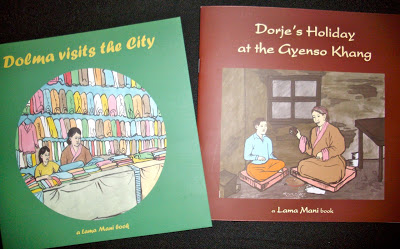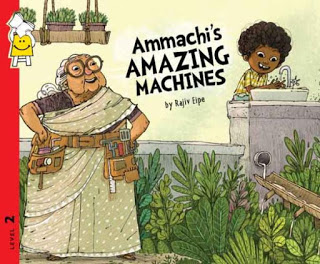World Tibet Day – The Story Behind Lama Mani Books

Think Tibet was set up with two fundamental objectives: to be a resource for young Tibetans in exile to learn about their society and culture in the face of constant change; to create awareness about the Tibetan people in the local community. The avenues to achieve these objectives are largely the arts – through art collaborations, theatrical workshops and productions, books for children and events that encourage dialogue and understanding of a community in exile. ( via 1shanthiroad)
A year later, Lama Mani Books has come out with two books for kids to talk about life in exile. On World Tibet Day, Aravinda agreed to do a guest post for our blog and give us some insight on how the project took shape.
It was on the night of 17th March in 1959 that a 23-year old Tibetan monk escaped from his summer palace in Lhasa. He was the 14th Dalai Lama, the spiritual and temporal head of the country in the Himalayas. Ironically, he walked out the doors of his palace, dressed as a soldier. No one recognized him. It was a long and difficult journey down the mountain, and the Dalai Lama and his entourage also had the Chinese army to watch out for. A week later, they were able to pause and a messenger was sent to India, seeking asylum from Prime Minister Nehru. The journey continued with great difficulty and it was a fevered Dalai Lama who crossed the border on 31st March 1959. He was followed by tens of thousands of Tibetans who heard of their ‘Kundun’s’ dramatic escape with enormous relief. The decision to escape may not have been an easy one to make and indeed, life in India was harder than any they may have known. The tropical climate was a shock to these nomadic people. Furthermore, the only immediate employment was as coolies on the Manali road construction. The first refugee camp came up at Bylakuppe, near Coorg, in Karnataka in 1960. Other camps came up at various places, wherever a state government offe
red land. Karnataka has five settlements in all and is also home to the three main monasteries in Tibetan Buddhism, along with other smaller monasteries.
It was a decade ago that I first interviewed a Tibetan sweater seller. His name was Dorje. Sitting on the pavement amidst the piles of sweaters in Majestic, we spoke in Hindi, a language neither of us knew very well. He spoke of walking from Tibet and fighting in the Bangladesh war, for India, and his woes as a sweater seller. We spoke for a long time and when I took leave, he said, ‘I wish to die in Tibet.’
Over the years, I’ve heard that echoed many times over by many Popo-las and Momo-las (grandpas and grandmas). And it always bothers me to hear it.
When my friend Jangchup finished college a couple of years ago, he said he’d like to do something for his people; I offered to help. One of the things we eventually decided to take up was publishing of children’s books. We found that in Tibet there were storytellers who went from place to place with their scrolls of thangkas, narrating the grand old epics. They were the Lama Manis of Tibet. We also found that the Tibetan epic of Gesar Ling is the world’s last living epic, the Iliad of the East as some call it. With such a tradition of storytelling, and such a vast cultural history to draw from, we set up Lama Mani Books, our tribute to the storyteller and our contribution to the community.
Our intent is not to rehash folk tales or Buddhist stories but instead tell stories of here and now. Consequently, our first two titles are part of a series we call ‘Meyul’, a Tibetan word that has no English equivalent but best describes the place that’s not one’s home. The books were designed to introduce life in exile, and describe how people lived and worked while keeping up their identity. Our first stop was the old age home, or gyenso khang as it’s called, at Doeguling refugee camp, Mundgod. It’s the first old age home set up in exile, whose residents
have all journeyed from Tibet half a century ago. We were struck by the serenity and the hope of the people who had contended with so much. No one complained to us and we were met with a ready smile on every visit. From this came the story of Dorje’s Holiday at the Gyenso Khang. For our second title, we chose the most visible section of the Tibetan community, the sweater sellers. I didn’t meet Dorje, the sweater seller again but seeing the Tibetan sweater sellers dressed in their chubas and sitting in their stalls on the crowded Indian pavements, I couldn’t help but feel they must long for home sometime. And hence the story of Dolma Visits the City.
Both these books are set in real places, among real people and animals even. They will be available in bookstores shortly. But for now, they are taking email orders and can be contacted at [email protected]
PS: A Tibetan edition of the books is in progress
(Aravinda is a member of Think Tibet. Loves reading, writing, being with animals. Works with Hippocampus, an organisation that promotes reading among children. Lives in Bangalore with her husband and dog.)






